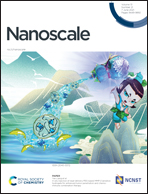Self-assembly of virulent amyloid-derived peptides into nanoantibacterials†
Abstract
Current strategies for the design of antibacterial peptides show limitations in the development of assembled antibacterial peptides due to the challenges in simultaneously balancing the antibacterial activity and assembling behavior. Herein, we report on one strategy for the design of antibacterial peptides derived from virulent amyloids and investigate their self-assembly into nanostructures with remarkable antibacterial activity. The peptides were either directly truncated from virulent amyloid peptide PSM α3 or mutated from the original sequence by replacing the lysine and phenylalanine residues with arginine or tryptophan, leading to three undecapeptides. Conformational and morphological results indicated the formation of nanotubes and twisted nanoribbons by the truncated peptide and the mutated peptide, respectively, predominately driven by anti-parallel β-sheets. Bacterial culturing experiments revealed that the two mutated peptides possessed remarkable antibacterial activity against both Gram-positive and Gram-negative bacteria by disrupting the bacterial membrane at a concentration above their critical aggregation concentrations, thus leading to two nanoantibacterials. Our findings demonstrate that biomimetic peptides originated from virulent amyloids exhibit great potential in the development of assembled antibacterial peptides, thus providing a new strategy for simultaneously addressing the antibacterial activity and pharmacokinetics of natural antibacterial peptides in the future.



 Please wait while we load your content...
Please wait while we load your content...